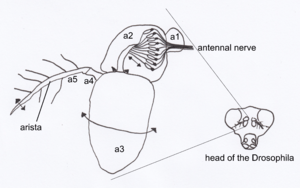Scolopidia

A scolopidia (historically scolopophore) is the most fundamental unit of a mechanoreceptor organs in insects. It is a composition of three cells, a scolopale cap cell which caps the scolopale cell, and a bipolar sensory nerve cell. Scolopidia are sensitive to things like sound (vibrations of the air) or substrate vibrations (feeling vibrations on a leaf, for instance) depending on the structure of the overall sense organ in which they reside.
These organs ultimately convert mechanical vibration into a nerve impulse which is sent on to higher ganglion where the information is combined and/or processed into a resultant behavior.
The general term of these overall sense organs is the chordotonal organs, with the scolopidia usually lying just under the exoskeleton. A specific example of the chordotonal organ would be the subgenual organ (in the lower part of the legs; senses vibrations in the ground), the crista acustica (a collection of individually tuned scolopidiae which can discriminate frequencies, or Johnston's organ (in the antennae; senses motion of an antenna relative to the insect's body).[1] There are many types of scolopidia, depending on the sense organ in which they belong, and the terminology among the scolopidia is not always uniform.[2]
There are two types of scolopidia, one whose distal end (the cap end) is contained within the body wall of the insect (subintegumental) or one whose distal end is free (integumental). For example, the integumental type is found in the subguneal organ (also known as the supratypanal organ) while the subintegumental type is found in the crista acustica and the intermediate organ. The subguneal organ ('organ below the knee') is found in all insects legs, and the probably an evolutionary artifact of prior insect body-types which used their legs to detect vibrations from the substrate (viz., treehoppers). The intermediate organ and the crista acustica, on the other hand, are only found where there is a tympanum, such as on the front legs of insects.
See also
References
- ↑ The Insects: An Outline of Entomology, P. J. Gullan, Peter Cranston.
- ↑ Methods in insect sensory neuroscience, Thomas A. Christensen
- The insects: structure and function, R. F. Chapman, Reginald Frederick Chapman.